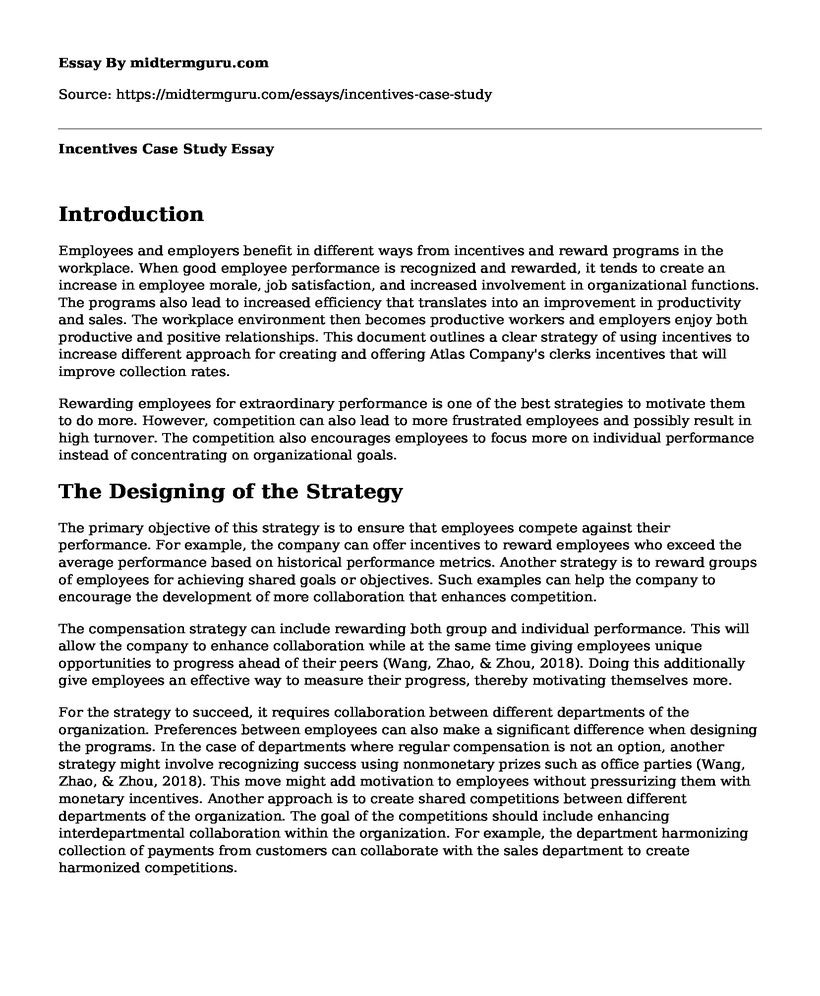Introduction
Employees and employers benefit in different ways from incentives and reward programs in the workplace. When good employee performance is recognized and rewarded, it tends to create an increase in employee morale, job satisfaction, and increased involvement in organizational functions. The programs also lead to increased efficiency that translates into an improvement in productivity and sales. The workplace environment then becomes productive workers and employers enjoy both productive and positive relationships. This document outlines a clear strategy of using incentives to increase different approach for creating and offering Atlas Company's clerks incentives that will improve collection rates.
Rewarding employees for extraordinary performance is one of the best strategies to motivate them to do more. However, competition can also lead to more frustrated employees and possibly result in high turnover. The competition also encourages employees to focus more on individual performance instead of concentrating on organizational goals.
The Designing of the Strategy
The primary objective of this strategy is to ensure that employees compete against their performance. For example, the company can offer incentives to reward employees who exceed the average performance based on historical performance metrics. Another strategy is to reward groups of employees for achieving shared goals or objectives. Such examples can help the company to encourage the development of more collaboration that enhances competition.
The compensation strategy can include rewarding both group and individual performance. This will allow the company to enhance collaboration while at the same time giving employees unique opportunities to progress ahead of their peers (Wang, Zhao, & Zhou, 2018). Doing this additionally give employees an effective way to measure their progress, thereby motivating themselves more.
For the strategy to succeed, it requires collaboration between different departments of the organization. Preferences between employees can also make a significant difference when designing the programs. In the case of departments where regular compensation is not an option, another strategy might involve recognizing success using nonmonetary prizes such as office parties (Wang, Zhao, & Zhou, 2018). This move might add motivation to employees without pressurizing them with monetary incentives. Another approach is to create shared competitions between different departments of the organization. The goal of the competitions should include enhancing interdepartmental collaboration within the organization. For example, the department harmonizing collection of payments from customers can collaborate with the sales department to create harmonized competitions.
Measuring the Effectiveness of the Program
There are different ways to track the progress of the launching of the program. One way to track progress is through the use of data against a predetermined benchmark. For example, if the goal of the competition is to increase collection rates of clerks, information from the competition in the sales department can be correlated with data from another department, such as purchasing, to identify interesting patterns. Interdepartmental competitions all corporations can also help employees to think outside the box and understand how departments influence each other with the organization (Wang, Zhao, & Zhou, 2018).
Another way to measure the effectiveness of the program is to include employee surveys designed to understand whether employees agree or disagree with any existing competitions. Ultimately, the ultimate benchmark has to do with the state of the organization's turnover figures. If turnover is increasing, that could be a good sign that the competition is doing well. Also, if competitions affect sales figures negatively, then it could be an indication that they are stressing employees and preventing them from performing optimally. Finding the balance between collaboration and competition is not always easy, and in most cases requires a process of trial and error to narrow down on factors within the organization's control that can help to increase productivity and organizational performance.
References
Wang, L., Zhao, J. Z., & Zhou, K. Z. (2018). How do incentives motivate absorptive capacity development? The mediating role of employee learning and relational contingencies. Journal of Business Research, 85(6), 226-237. doi:10.1016/j.jbusres.2018.01.010
Cite this page
Incentives Case Study. (2022, Sep 25). Retrieved from https://midtermguru.com/essays/incentives-case-study
If you are the original author of this essay and no longer wish to have it published on the midtermguru.com website, please click below to request its removal:
- Essay on Global Leadership and Management Issues in the 21st Century
- Essay on Leadership as One of the Aspects of the Development of Effective Learning Institutions
- Essay Sample on Physical Intervention Program Among Sedentary Workers
- Classification Essay Sample on Theories of Leadership
- Leaders: Avoid Communication Missteps to Nurture Organizational Growth - Essay Sample
- Internship Progress: Verbal, Non-Verbal, & Written Means
- Creating a Change Management Plan: Lewin's 3-Step Model & Action Research - Essay Sample







